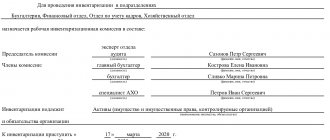O.I. Prokhorova author of the article, Ascon consultant on accounting and taxation
All organizations are required to conduct an inventory before drawing up annual financial statements (Part 2, Article 11 of the Federal Law of December 6, 2011 N 402-FZ, clauses 26, 27 of the Regulations on Accounting and Financial Reporting, approved by Order of the Ministry of Finance of Russia dated July 29, 1998 N 34n (hereinafter referred to as Regulation No. 34n), clause 27 of the Guidelines for inventory of property and financial obligations, approved by Order of the Ministry of Finance of Russia dated June 13, 1995 N 49 (hereinafter referred to as Guidelines for Inventory), clause 38 PBU 4/99, Appendix to the Letter of the Ministry of Finance of Russia dated 01/19/2018 N 07-04-09/2694, Appendix to the Letter of the Ministry of Finance of Russia dated 01/09/2013 N 07-02-18/01).
The purpose of the annual inventory is to identify the actual availability of property, compare it with accounting data, check the completeness of the reflection of liabilities in accounting, ensure the reliability of accounting data and financial statements (clause 1.4 of the Inventory Guidelines).
How to form an inventory commission
According to the Methodological Instructions for Inventory (approved by Order of the Ministry of Finance dated June 13, 1995 No. 49, hereinafter we will simply call them Instructions), it should be carried out by an inventory commission .
These Instructions impose conditions :
- number of members – at least 3 people ;
- financially cannot participate in the commission .
Accordingly, organizations with a small number of employees have a question: what to do if it is impossible to form an inventory commission from the existing employees - as required by the Directions? For example, the company has only 5 employees, of which three are financially responsible.
Let us immediately note that such circumstances are not a reason not to carry out an inventory. In clause 38 of PBU 4/99 “Accounting statements of an organization” and clause 26, clause 27 of the Regulations on accounting and financial reporting, such exceptions are not provided .
There is only one way out in such circumstances - to involve outside . For example, clause 2.3 of the Guidelines allows for the involvement of employees of independent audit companies in the inventory.
If an already appointed member of the inventory commission does not show up for the inventory (for example, he got sick), there are 2 options for getting out of the situation:
- Pause inventory.
- Appoint a replacement for the absent person by a separate order from management.
We do not recommend conducting an inventory with incomplete commission . If the inspectors subsequently discover that one of the participants physically unable to be present during the recount (for example, the documents contain his sick leave or a business trip report), the inventory will be considered formal , and its results will be invalid.
This is a gross violation of accounting rules. It is punishable under Art. 15.11 of the Code of Administrative Offenses of the Russian Federation with a fine of 5,000 - 10,000 rubles for violation imposed on company officials. If the violation occurs repeatedly, the fine is doubled , and officials responsible for accounting in the organization may be disqualified for up to 2 years .
Legislative framework
Control over the safety of one’s own assets is the direct task of every economic entity.
To do this, the company's management is obliged to organize the maintenance of reliable accounting records and ensure timely recording of transactions. But accounting alone is not enough. Constant monitoring of the compliance of accounting indicators and actual availability is required. It is this problem that is solved by systematic inventories.
Carrying out an inventory before preparing annual reports is a mandatory procedure for all companies, regardless of ownership, organizational and legal forms, type and type of institution. The requirement is enshrined at the legislative level:
- in Law No. 402-FZ, namely paragraph 3 of Article 11;
- in the order of the Ministry of Finance of Russia No. 34n.
The purpose of control measures is to ensure the reliability of accounting and confirm the data of financial statements. In addition, systematic checks help ensure the safety of assets and reduce the number of thefts. Control will identify unused resources and also avoid ineffective spending.
How to suspend activities while taking inventory
A company with a small staff may have a large amount of inventory or a large product range. In addition, small and medium-sized businesses have every buyer or client “on their account.” Therefore, neither the owners nor the management want to close, for example, a store or a catering outlet for several days (especially in the days before and after the New Year).
How to fulfill the condition of the Instructions on the suspension of the movement of material assets during the inventory?
inventory plan before the event begins .
EXAMPLE
If the company has a separate store (shops) and a warehouse, you can recalculate the warehouse on one date, allowing the store to work as usual (make the appropriate delivery of goods from the warehouse in advance), and count the store on the next date, choosing the most suitable time for this.
In practice, the recount of a retail outlet is often scheduled outside of its normal operating hours or in such a way that the overlap between inventory time and operating hours is small . As a rule, when recalculating a point, you can do it in less time than when recalculating a warehouse, so some temporary shift can be organized.
In this case, the company conducting the recalculation should remember the rules for involving employees in overtime work. For example, if a salesperson works a regular shift and then stays to take part in inventory, then this would be overtime .
In a situation where it is impossible to completely stop work during the recalculation, you can apply the rules for the arrival and departure of valuables during inventory. They do this as follows:
- if during the inventory something arrived at the warehouse (for example, a car with goods arrived), then it is permissible for the financially responsible person to carry out acceptance in the presence of members of the commission. In this case, the receipt is recorded in a separate document - the inventory “Inventory assets received during inventory”. When comparing balances at the beginning of the inventory according to documents with actual balances of inventory items for this separate inventory, they are not taken into account ;
- if during the inventory you need to ship something (for example, an order to a buyer placed before the start of the recount), for such an operation you must obtain written permission from the manager and chief accountant. The release of goods and materials should also be carried out by the mat. responsible persons in the presence of members of the commission. For inventory items disposed of in this way, there is also a separate inventory “Inventory items released during inventory counting.” Registration of disposal of mat. by the responsible person in the presence of the commission in this case is equivalent to a recount . That is, the results of inventory items released during the inventory can participate in summing up the inventory.
EXAMPLE
If product A at the time of shipment had not yet been counted by the commission, 5 pieces were released according to the inventory, 10 pieces were added to the inventory list after counting, the total balance according to the documents was 15 pieces, then there is neither a shortage nor a surplus for product A.
If during the inventory there are internal movements (for example, goods from an already counted own warehouse arrived at the store while the inventory is being taken there), this needs to be documented in the same way - with a separate inventory for the receipt of goods and materials during the inventory. To ensure that inventory results (especially with internal movements) do not contain errors , the accountant needs in advance correct separate accounting for storage locations of inventory items.
REFLECTION OF ACCOUNTS RECEIVABLE IN ACCOUNTING
Accounts receivable is a type of asset. There is no definition of the concept “asset” in the regulations of the Russian Federation. To determine assets, you can be guided by clause 8.3 of the Concept of Accounting in the Market Economy of Russia, approved by the Methodological Council on Accounting under the Ministry of Finance of Russia, the Presidential Council of the Institute of Professional Accountants on December 29, 1997:
“An asset is recognized in the balance sheet when it is probable that future economic benefits from the asset will flow to the entity and when its value can be measured reliably.”
Accounts receivable arise when the counterparty fails to fulfill its obligations. Based on Art. 309 of the Civil Code of the Russian Federation (hereinafter referred to as the Civil Code of the Russian Federation), obligations must be fulfilled properly in accordance with the conditions and in compliance with the requirements of the law, other legal acts, and in the absence of such conditions and requirements - in accordance with customs or usually imposed requirements.
Unilateral refusal to fulfill an obligation and unilateral change of its conditions are not allowed .
In addition, accounts receivable balances may be based on a temporary factor, namely, urgent prepayment or postpayment conditions, based on the terms of the contract.
Accounts receivable include amounts of debt of third parties to the organization that arose during settlements with banks, the budget, extra-budgetary funds, employees, buyers, suppliers, accountable persons, and other debtors (clauses 3.44–3.48 of the Methodological Instructions, letter from the Ministry of Finance of Russia dated 01/09/2013 No. 07-02-18/01).
Accounts receivable are reflected in accounting as the debit of accounts 62, 76 on the basis of correctly executed primary documents. It arises in the event of non-payment for work performed (services provided, goods supplied) that were formalized:
- agreement, invoice-offer addressed to the buyer,
- act of acceptance and delivery of work (services), invoice for shipment, signed by the parties to the transaction.
When making payments (payment order, cash order) and there are no supporting documents for offsetting payments against transactions performed by the company (sales receipts from accountable persons, invoices for the supply of goods from suppliers, accrual of tax obligations to the budget, accrual of obligations to employees), debit ending balances arise for accounts 60, 71, 68, 69, 70, 76.
IT IS IMPORTANT
The amounts of receivables are indicated by each debtor and each contractual obligation with him.
Accounts receivable can also arise in non-cash settlements between the parties to a transaction on the basis of a formalized act of offset, debt novation, etc.
In all cases, the consequences of its occurrence are reflected in the form of a debit balance (including on off-balance sheet accounts) at the end of the reporting period.
It is important to check the legitimacy of this balance before drawing up the annual report, since its presence shows all interested parties a liquid asset that potentially brings financial resources to the company’s budget upon its repayment.
Is the presence of financially responsible persons required during inventory?
As a general rule, the financially responsible person must be present during the inventory. But only entrusted to him . Yes, mat. responsible employees of a separate warehouse must be present during the recount by the warehouse commission, but are not required to be, for example, in a store where store employees are responsible for the safety of inventory items.
What if checkmate? the responsible person cannot be present during the recount due to objective reasons? Is it possible to carry out an inventory?
It is possible , but subject to several mandatory steps :
1. Mat. The responsible employee should be given a written invitation to be present during the recount of the valuables entrusted to him. To which the employee must also give a written response , in which he sets out the reasons why he cannot be included in the inventory.
If this requirement cannot be met (for example, the employee is absent for unknown reasons), an act of absence is drawn up.
2. Based on the employee’s response or absence certificate, the manager needs to issue an order to conduct a recount in the absence of the financially responsible person.
3. In all inventory documents, in places where an absent employee should be noted, entries are made that he is absent and for what reason. Each such record is certified by the signatures of all members of the commission.
4. Allowed instead of swearing. responsible person to attract independent witnesses to observe the recount. If necessary (for example, when the material person in charge challenges the inventory results), witnesses can confirm that the process was carried out without violations on the part of the commission.
Composition of inventory property
The key principles and procedure for conducting inventories are enshrined in Order No. 49 of the Ministry of Finance of the Russian Federation dated June 13, 1995. Thus, all property and liabilities of the company are subject to mandatory control before preparing financial statements.
List of items to be inventoried:
1. Property is all categories of company assets that are owned:
- fixed assets;
- materials and raw materials;
- finished products;
- cash and cash equivalents;
- financial investments;
- receivable;
- intangible assets used in activities.
In addition to property, it is necessary to control the actual presence of assets that do not belong to the subject. For example, property transferred for safekeeping or leased. These assets are held in off-balance sheet accounts.
Pay special attention to objects that are not taken into account for some reason.
2. Liabilities: includes certain categories of sources of property formation. Specifically, we are talking about accounts payable, as well as the amounts of borrowed capital and loans received to conduct business.
What are the ways to carry out inventory starting in 2021?
Until recently, in practice there were only 2 ways of conducting inventory: natural and documentary.
Let us remind you:
- Natural inventory is the direct observation of inventory objects, their recalculation, measurement, weighing, etc., as well as the establishment of their actual quantity.
- Documentary inventory is a revision of documentation in order to document the presence/absence of inventory items.
With the advent of the COVID-19 pandemic in our lives in 2021, another method of inventory has appeared - remote. That is, with the help of audio and video recording and communication means.
Of course, such an inventory cannot be completely . Someone must be, for example, in a warehouse or at a point, carrying out a physical count. In this case, it is permissible for other participants (for example, members of the inventory commission) to observe the process remotely . Thus, the restrictions necessary to counter the spread of the virus are implemented.
Inventory using audio and video recording and communications means is permissible temporarily . For now - between the end of 2020 and the beginning of 2021.
It is important to remember that any inventory method used must first be prescribed in accounting policies . Therefore, having decided to carry out an inventory taking into account current sanitary and epidemiological requirements, you must first include this method in the accounting policy, and only then issue an order to conduct an inventory.
Read also
25.07.2019










